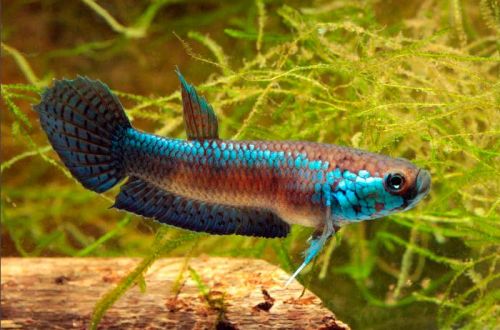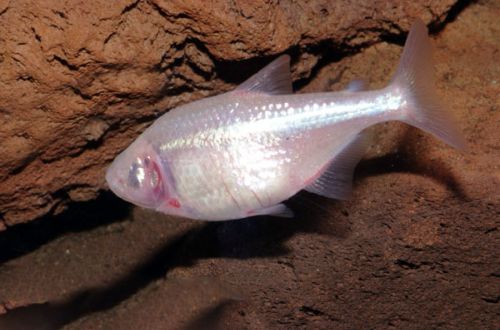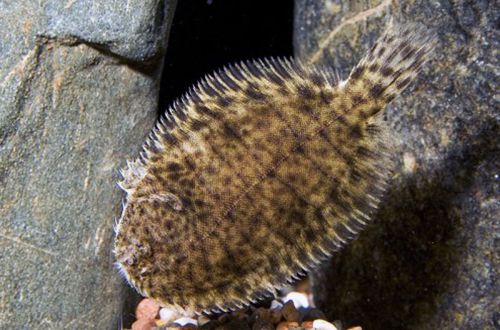
Betta unimaculata
Betta unimaculata, scientific name Betta unimaculata, belongs to the Osphronemidae family. Belongs to the group of fighting fish and fully corresponds to its affiliation. Males are quite temperamental, rivals tend to arrange skirmishes for territory and the attention of females. The latter are also sometimes not averse to “arguing”, especially in a small aquarium. Behavioral traits aside, they are considered relatively easy to keep and may be compatible with other species.

Contents
Habitat
It comes from Southeast Asia from the Indonesian part of the island of Borneo. Inhabits the basin of the Mahakam River, which flows mainly in the province of East Kalimantan. It is found throughout the course, from clear clear streams flowing down the hills to wetlands among tropical rainforest. Despite the diversity of natural habitats, the fish prefers regions with a slow current, backwaters, where it hides among snags, aquatic or overhanging coastal vegetation.
Brief information:
- The volume of the aquarium – from 70 liters.
- Temperature – 21-26°C
- Value pH — 5.0–7.5
- Water hardness – 1–10 dGH
- Substrate type – any
- Lighting – subdued
- Brackish water – no
- Water movement – weak or absent
- The size of the fish is 10–11 cm.
- Food – any food
- Temperament – conditionally peaceful
- Content – singly or in pairs male / female
Description
Adults reach a length of 10-11 cm. The fish have an elongated slender body. The main color is dark brown-yellow. In males, unlike females, the fins are larger, and the scales have a turquoise tint. Otherwise, sexual dimorphism is weakly expressed.
It is noted that populations from different localities show differences in coloration and patterns, so they should not be kept together to avoid hybridization. Collectors and enthusiasts mark such individuals with additional marker words, for example, Mahakam, Sandakan, Tawau, etc., meaning a pure pedigree.
Food
In nature, it feeds on small insects and other invertebrates, zooplankton. In the artificial environment, they have adapted to alternative products. The daily diet may consist of dry food in the form of flakes, pellets, combined with live or frozen brine shrimp, daphnia, bloodworms, etc.
Maintenance and care, arrangement of the aquarium
The optimal size of the aquarium for one pair starts from 70 liters. The choice of design is a matter of personal taste. Some breeders prefer not to use a substrate for ease of maintenance, and pet stores often have fish in completely half-empty tanks. Of course, this does not mean that such an “empty” environment is ideal, but it indicates the unpretentiousness of the Betta unimaculata. It will look most harmoniously among snags and shade-loving plants in subdued lighting conditions. Having a few hiding places will not be superfluous, which is especially useful during breeding. Placing the leaves of some trees at the bottom will add naturalness to the design and positively affect the composition of the water, making it look like the one in which fish live in nature. Read more in the article “Which tree leaves can be used in an aquarium.”
When keeping, it is important to ensure stable water conditions in the allowable range of temperatures and values of hydrochemical parameters. The biological balance in the aquarium depends entirely on the regularity of the mandatory maintenance procedures (water changes, waste disposal) and the smooth operation of the equipment.
Behavior and Compatibility
Males compete with each other for leadership in the intraspecific hierarchy. Their skirmishes can sometimes be violent, so it is advisable to keep only one male in a small tank, or together with a female, provided that they grew up together or were bought from the same group. If the male and female were purchased from different suppliers and are together for the first time, then with a high probability they will not be able to get along. In large volumes of water, there are no such restrictions. Compatible with other non-aggressive species of comparable size.
Breeding / breeding
Betta unimaculata and other related species have evolved a breeding strategy that is not typical for most fish, or rather, a way to protect offspring. During spawning, the fish perform a “hug dance” during which the eggs are fertilized. The eggs immediately end up in the mouth of the male, who wears them throughout the entire incubation period of 10–14 days.
In this regard, breeding is quite simple, it is much more difficult to find a compatible pair. As mentioned above, you cannot house a male and a female together and expect that they will soon begin to breed. The fish should grow up together and be accustomed to each other. If it is not possible to keep groups (the aquarium is too small), then when buying, it is worth giving preference to a pair that has already given offspring before, but here a new problem arises with their identification from a large number of fish.
Fish diseases
The cause of most diseases is unsuitable conditions of detention. A stable habitat will be the key to successful keeping. In the event of symptoms of the disease, first of all, the quality of the water should be checked and, if deviations are found, measures should be taken to correct the situation. If symptoms persist or even worsen, medical treatment will be required. Read more about symptoms and treatments in the Aquarium Fish Diseases section.





